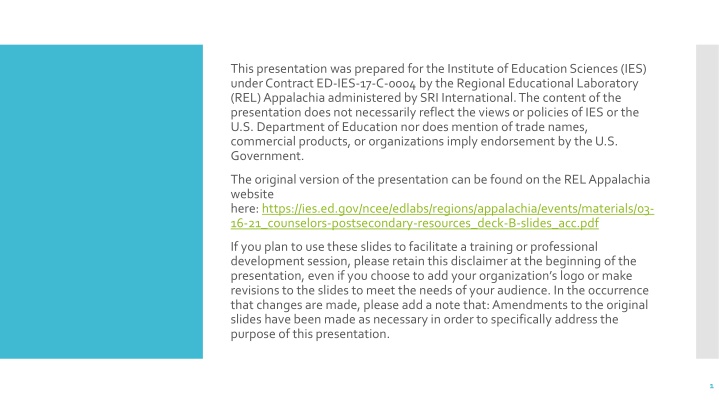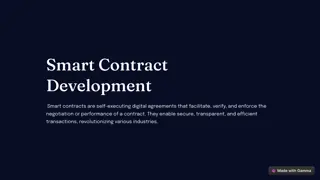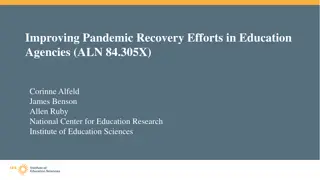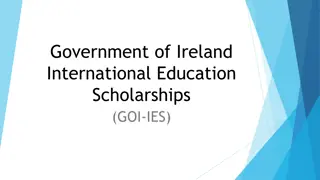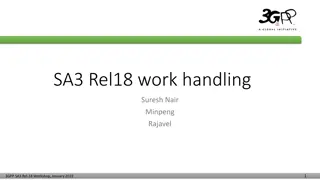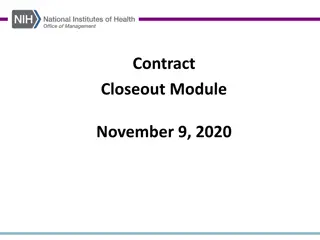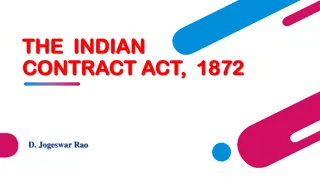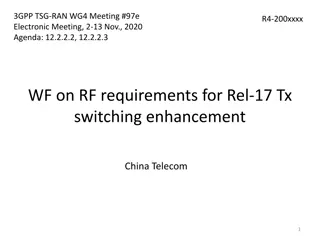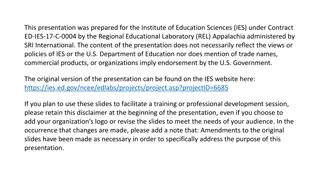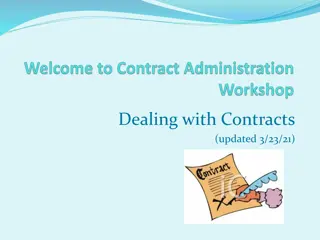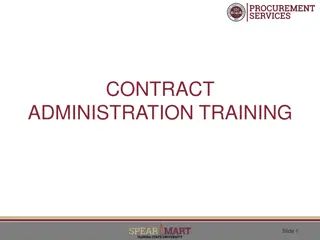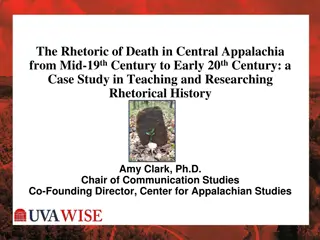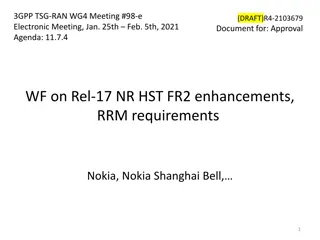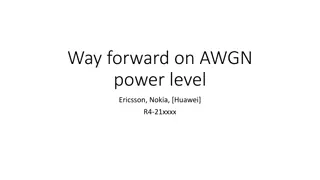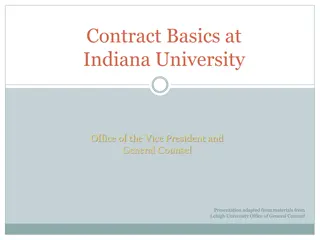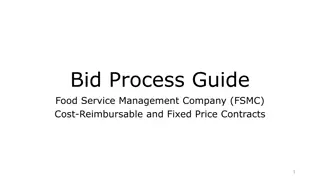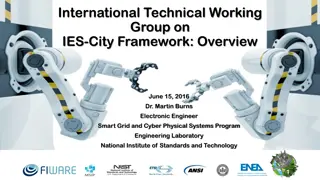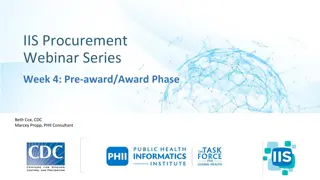Research Presentation by REL Appalachia for IES Contract
Presentation by REL Appalachia for IES Contract ED-IES-17-C-0004. Prepared by SRI International, focusing on educational research and initiatives in Appalachia.
Download Presentation

Please find below an Image/Link to download the presentation.
The content on the website is provided AS IS for your information and personal use only. It may not be sold, licensed, or shared on other websites without obtaining consent from the author.If you encounter any issues during the download, it is possible that the publisher has removed the file from their server.
You are allowed to download the files provided on this website for personal or commercial use, subject to the condition that they are used lawfully. All files are the property of their respective owners.
The content on the website is provided AS IS for your information and personal use only. It may not be sold, licensed, or shared on other websites without obtaining consent from the author.
E N D
Presentation Transcript
This presentation was prepared for the Institute of Education Sciences (IES) under Contract ED-IES-17-C-0004 by the Regional Educational Laboratory (REL) Appalachia administered by SRI International. The content of the presentation does not necessarily reflect the views or policies of IES or the U.S. Department of Education nor does mention of trade names, commercial products, or organizations imply endorsement by the U.S. Government. The original version of the presentation can be found on the REL Appalachia website https://ies.ed.gov/ncee/edlabs/regions/appalachia/events/materials/03-16-21_counselors-postsecondary-resources_deck-B-slides_acc.pdf https://ies.ed.gov/ncee/edlabs/regions/appalachia/events/materials/03-16-21_counselors-postsecondary-resources_deck-B-slides_acc.pdf here:https://ies.ed.gov/ncee/edlabs/regions/appalachia/events/materials/03- 16-21_counselors-postsecondary-resources_deck-B-slides_acc.pdf If you plan to use these slides to facilitate a training or professional development session, please retain this disclaimer at the beginning of the presentation, even if you choose to add your organization s logo or make revisions to the slides to meet the needs of your audience. In the occurrence that changes are made, please add a note that: Amendments to the original slides have been made as necessary in order to specifically address the purpose of this presentation. 1
Supporting Students with the Nuts and Bolts of Postsecondary Transitions Paving the Pathway to College and Careers Training Series
Laying the foundation for postsecondary success Supporting students with the nuts and bolts of postsecondary transitions Building a postsecondary mindset Paving the pathway to college and careers 3
Welcome and overview Selection supports Application and assessment supports Financial supports Wrap-up and next steps Agenda 4
Provide an overview of research-based strategies related to the nuts and bolts of the postsecondary transition: selection, application and assessment, and financial supports. Meeting goals Walk away with at least one strategy to try. 5
Financial What kinds of nuts and bolts supports are needed? Application & Assessment Selection 6
Selection supports 7
How do your students make decisions about where to apply to school? What do you think? 8
Low-income, college-ready students are less likely to enroll in an institution that is a good match with their needs and interests. Why do fit and match matter? Students are more likely to persist in college if the institution is a good match, fitting their social, academic, and financial needs. (Bowen et al., 2009; Light & Strayer, 2000) 9
Assist students in their college search by: Helping students identify postsecondary programs that match their qualifications, interests, and goals. Supports for school selection Encouraging students to apply to a range of programs: safety, match, reach. Sharing information on net vs. sticker price. (Page & Scott-Clayton, 2016; Tierney, et al., 2009) 10
Application and assessment supports 11
The biggest barrier to students completing their postsecondary applications is _____________. What do you think? 12
How can application and assessment supports encourage postsecondary enrollment? 57 percent of high-achieving, low-income students reported that the application process was somewhat of a challenge, and 10 percent said it was a major challenge. 90 percent of economically disadvantaged students do not enter college the first semester after high school, in part due to missing application deadlines. (Corrigan; 2003; Giancola & Kahlenberg, 2016) 13
Help students create an email account for the application process. Create clear timelines for the process and communicate deadlines. Student-level supports for college applications Seek application fee waivers. Support students with essays. Support requests for letters of recommendation. Assign staff to ensure student applications are complete and of sufficient quality. (Page & Scott-Clayton, 2016; Tierney et al., 2009) 14
Integrate application steps into course requirements (e.g., English classes to write essays; advisory to set a timeline). System-level supports for college applications Hold postsecondary application weeks. Partner with college access organizations and/or postsecondary institutions. (Page & Scott-Clayton, 2016; Tierney et al., 2009) 15
Implement universal school-day testing policy. Offer assistance with testing fee waivers. Supports for assessment preparation and completion Establish a testing center on your high school campus. Communicate testing schedule and timeline through: - Emails and phone blasts. - Information tables at athletic events. Help students prepare with: - Training on test-taking. - Exam preparation or workshops (including direct tutoring, ordering practice tests, or using training software). (Page & Scott-Clayton, 2016; Tierney et al., 2009; Klasik, 2013) 16
Financial supports 18
Completion rates for graduating seniors have risen from 57.2 percent in the class of 2015 to 61.2 percent for the graduating class of 2019. 91.5 percent of students who complete the FAFSA enroll in college in the fall, compared to only 49.7 percent of students who do not complete the FAFSA. FAFSA completion matters Many students who do not complete the FAFSA would have qualified for federal Pell Grants. Estimates suggest students are missing out on up to $2.6 billion in college funding, with each student leaving behind an average of $4,000. (Helhoski, 2018; NCAN, 2019) 19
The biggest barrier to students completing their FAFSA application is _____________. What do you think? 20
Dont know about it. It s too long and too complicated. Why don t students complete the FAFSA? Fear of the cost of college and student debt. Believe they don t qualify for funds. Missed deadlines. Unwillingness to share personal information with the government. (Davidson, 2013; Hodara, 2017) 21
Compared with participants who received no information, or received only information without additional supports, participants who received information and personalized assistance had significant increases in FAFSA completion and college enrollment. Families need information and personalized assistance with FAFSA Early and accurate information has shown some evidence for improving FAFSA completion rates. (Bettinger et al., 2012; George-Jackson & Gast, 2016) 22
Provide detailed timelines for students and families. Implement in-class interventions. School-based activities to support FAFSA completion Build a school-based FAFSA team. Host FAFSA completion nights. Partner with local postsecondary institutions. Test small before going big. (Black, 2016; Scholarship America, 2020) 23
Using data to track and encourage FAFSA completion Use student and school-level data to know who s completed. Frequently monitor data. Track progress and impact of your interventions with data visuals (for example, charts). (Black, 2016) 24
U.S. Department of Educations Federal Student Aid website Provides current state and school-level data about FAFSA submissions and completions, updated regularly. Schools can obtain student-level data on completion status, but must first enter into a data sharing agreement. FAFSA tracking resources Form your Future, sponsored by the National College Access Network Provides data displays that track change over time at the state, district, and city level. https://formyourfuture.org/ https://formyourfuture.org/ https://studentaid.ed.gov/sa/about/data-center/student/application-volume/fafsa-completion-high-school https://studentaid.ed.gov/sa/about/data- center/student/application-volume/fafsa-completion- high-school https://studentaid.ed.gov/sa/about/data-center/student/application-volume/fafsa-completion-high-school https://studentaid.ed.gov/sa/about/data-center/student/application-volume/fafsa-completion-high-school 25
Wrap-up and next steps 26
Question and answer 27
Develop an action plan In which area do you want to improve? What specific strategies or considerations from today s presentation do you want to employ? - Refer to the Strategies and Possible Applications section of the resource compilation for more ideas. What s your plan? - Identify next steps. - Assign responsible parties and due dates. - Track progress. Continuing this journey How can you use what we discussed today? 28
